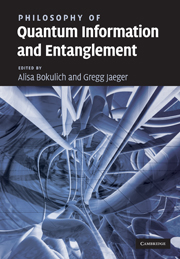Book contents
- Frontmatter
- Contents
- List of contributors
- Preface
- Introduction
- Part I Quantum entanglement and non-locality
- Part II Quantum probability
- Part III Quantum information
- 8 Schumacher information and the philosophy of physics
- 9 From physics to information theory and back
- 10 Information, immaterialism, instrumentalism: Old and new in quantum information
- Part IV Quantum communication and computing
- Index
9 - From physics to information theory and back
from Part III - Quantum information
Published online by Cambridge University Press: 04 August 2010
- Frontmatter
- Contents
- List of contributors
- Preface
- Introduction
- Part I Quantum entanglement and non-locality
- Part II Quantum probability
- Part III Quantum information
- 8 Schumacher information and the philosophy of physics
- 9 From physics to information theory and back
- 10 Information, immaterialism, instrumentalism: Old and new in quantum information
- Part IV Quantum communication and computing
- Index
Summary
Introduction
Quantum information theory is the study of how the peculiar features of quantum mechanics can be exploited for the purposes of information processing and transmission. A central theme of such a study is the ways in which quantum mechanics opens up possibilities that go beyond what can be achieved classically. This has in turn led to a renewed interest in, and a new perspective on, the differences between the classical and the quantum. Although much of the work along these lines has been motivated by quantum information theory – and some of it has been motivated by the conviction that quantum theory is essentially about possibilities of information processing and transmission – the results obtained, and the frameworks developed, have interest even for those of us who are not of that conviction. Indeed, much of the recent work echoes, and builds upon, work that predates the inception of quantum information theory. The significance of such work extends beyond the setting of quantum information theory; the work done on distinguishing the quantum from the classical in the context of frameworks that embrace both is something worthy of the attention of anyone interested in the foundational issues surrounding quantum theory.
One of the striking features of quantum mechanics lies in its probabilistic character. A quantum state yields, not a definite prediction of the outcome of an experiment, but a probability measure on the space of possible outcomes. Of course, probabilities occur also in a classical context.
- Type
- Chapter
- Information
- Philosophy of Quantum Information and Entanglement , pp. 181 - 207Publisher: Cambridge University PressPrint publication year: 2010
- 1
- Cited by



